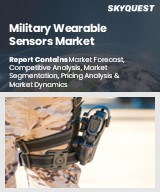
Report ID: SQMIG20A2333
Skyquest Technology's expert advisors continuously track and analyze the latest developments and updates related to military wearable sensors market. Our team of analysts stay abreast of all the recent news stories shaping the industry including new product launches by major companies, strategic partnerships, M&As, Patent filings and industry and regulatory developments.
REQUEST FOR SAMPLE
Global Military Wearable Sensors Market size was valued at USD 705.0 Million in 2023 and is poised to grow from USD 745.0 Million in 2024 to USD 1773.0 Million by 2032, growing at a CAGR of 11.4% in the forecast period (2025-2032).
Market leaders in the highly competitive military wearable sensor market are investing in mergers and acquisitions, strategic partnerships, and new product launches. To incorporate advanced technologies such as artificial intelligence (AI), machine learning, and miniature sensors into their wearable offerings, players are investing in research and development. Players can extend their offerings and win high-value defense contracts by partnering with technology firms and establishing relationships with government defense organizations. 'Anduril Industries (USA, 2017): One of the defense tech companies, Anduril Industries, is applying AI-driven solutions to transform warfighting. While the company is best recognized for autonomous platforms like the Roadrunner interceptor and Ghost drone, its technology ecosystem also incorporates advanced wearable sensor capabilities that integrate with battlefield networks. On the battlefield, the sensors drastically enhance situational awareness and mission effectiveness by providing troop tracking, threat detection, and real-time data exchange.', 'Shield AI (USA, 2015): A military-focused company, Shield AI is designing autonomous aircraft systems to assist in military operations in high-risk environments. While its iconic drones handle mapping and reconnaissance, the company also advances the wearable sensor space by creating technology that gives soldiers real-time environment and mission-critical information. Integrations enhance operational decision-making, mitigate threat risk, and assist in the creation of fighting strategies.', 'Honeywell International', 'SOSSEC, Inc.', 'Philips Healthcare', 'Bosch Security Systems', 'Smiths Group', 'Thales Group', 'Siemens AG', 'Rockwell Collins', 'Boeing', 'Northrop Grumman', 'Sensoil', 'Medtronic', 'Zebra Technologies', 'Verizon Communications', 'Sensirion AG'
The demand for advanced wearable sensors is being fueled by global initiatives to bring their militaries into the modern era. Beyond the improved health and effectiveness of troops, the sensors offer timely information which is indispensable to combat operations decision-making. To improve their tactical advantage on the battlefield, nations are spending considerably on these wearable technologies as means grow and a push for technological advancement is placed.
Integration of Machine Learning and AI: One of the key trends driving the growth of the military wearable sensors market is increasing integration of machine learning and AI technologies. These technologies enable predictive analytics and real-time decision-making by processing data from sensors. AI enables monitoring of health, detection of anomalies, and actionable insights, thus enhancing the efficiency and strategic planning of armed forces.
How Asia-Pacific is Leading the Way in Military Wearable Sensor Advancements?
Want to customize this report? This report can be personalized according to your needs. Our analysts and industry experts will work directly with you to understand your requirements and provide you with customized data in a short amount of time. We offer $1000 worth of FREE customization at the time of purchase.
Feedback From Our Clients

Report ID: SQMIG20A2333
sales@skyquestt.com
USA +1 351-333-4748